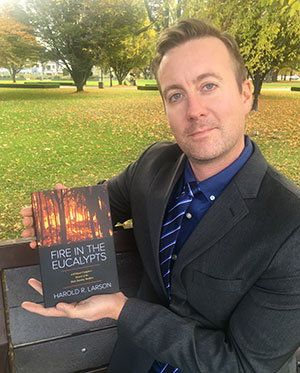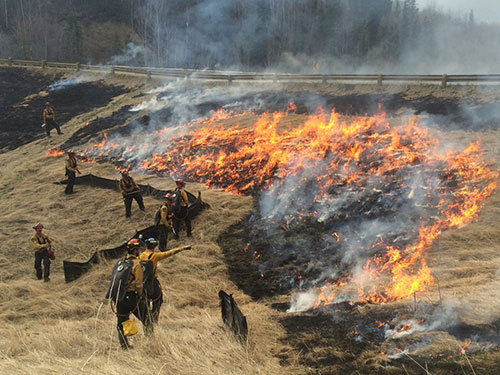Veteran firefighter Harold Larson describes what it takes to battle a blaze

Harold Larson (Forest Technology ’13) lasted about 6 months at the desk job he’d gone to school to get. It wasn’t that he disliked the roles of ranger and coordinator of an Alberta helitack crew, the helicopter squads essential to early wildfire-fighting efforts. He simply missed the work he’d done all his life.
Larson, who’s now 33, had been fighting wildfires since his Grade 11 summer break. He’s worked in the U.S., throughout Canada and even Australia, where he battled the Black Saturday Bushfires, a harrowing story he tells in his 2016 book, Fire in the Eucalypts.
With a passion for firefighting that couldn’t be extinguished, he resigned as manager, took a job as crew leader and reclaimed job satisfaction that might baffle those of us fond of sleeping in our own beds, having weekends off, air conditioning, and the concept of remote only when it’s associate with control.
Now the leader of a 20-person wildfire-fighting crew, Larson has never regretted his decision to return to the line. “I love my job,” he says. “I couldn’t see myself doing anything else right now.” We talked to him this summer before he left for B.C. to assist with their wildfires. Here, Larson offers a look at the life that, despite its challenges, drew him back to the flames.
Taking the heat
“It’s not uncommon to work more than 12 hours a day, usually between 14 and 18 days. It’s very physically demanding work. You’re pretty fatigued after a shift like that.”
“[The heat] can be stifling. We wear Nomex uniforms – they’re not fire proof but they’re fire resistant. We always have our helmets on and we carry backpacks full of gear, which are 20 pounds. When we’re going to wildfires in the initial stages we’re carrying pumps and hose – so a lot of times around 80 pounds of gear. That adds to the heat.”
 “The last wildfire I was in was burning over muskeg. Muskeg is like walking on a giant, spongey mattress and your feet are getting wet. [The trees] are burnt and have no needles or branches, so for 12 hours a day the sun is crushing you while you’re trying to work beside fire.”
“The last wildfire I was in was burning over muskeg. Muskeg is like walking on a giant, spongey mattress and your feet are getting wet. [The trees] are burnt and have no needles or branches, so for 12 hours a day the sun is crushing you while you’re trying to work beside fire.”
Eating and drinking
“Some days I drink 20 bottles of water. Food, you’re probably trying to intake 6,000 or 7,000 calories in a day. It’s usually the standard breakfast: bacon, eggs, sausage, pancakes, that kind of stuff. And then for lunch it’ll be sandwiches. And nuts, granola bars, fruit, pastries. At the end of the day it’s always pasta and salad. Once a week we get steak night, which is a treat.
“Some days when I’m scouting fires I’m walking up to 30 kilometres a day. I’ll lose 20 to 30 pounds by the end of the season.”
Overnighting at a fire
“It’s not something we do a lot in Alberta anymore but it does happen. Sometimes you have tents and sometimes you don’t. Last time I [stayed overnight] at a fire we didn’t. We made a fire and slept beside it. It gets really cold. Fires in this part of the country don’t really burn at night, they just smoulder. And when the heat comes out in the day it starts up again.”
Tactics and strategy
“Part of my job is to anticipate what the crew is going to do in the next day and the next hour. So I have to see what water sources there are, the topography, and adjust our plans accordingly. When I first started it was different, since now I can, for lack of a better term, see the forest for the trees.”

“My time at NAIT made me a better firefighter, now that I know more about the forest and its intricate nature. Being able to identify trees helps influence my tactics. I can look ahead and get a feeling for what the forest is going to be like.”
“If I see aspen and white spruce, I know it’s not going to be as wet there. But if I see black spruce and tamarack I know it’s going to be a poor-nutrient site that’s probably holding a lot of stagnant water and muskeg. It might be flash and burn through there but after it’s done there’s going to be water for me to [use].”
It’s like family
“I work with the same crew 8 months a year usually. I live with these people 24 hours a day, so they become like brothers and sisters. I like that tight-knit family that you overcome challenges with every day. You’re making a difference.”
Building resilience
“Firefighting has taught me that you can handle almost anything if you put your mind to it. When I go back to ‘the real world,’ the little things that people find challenging don’t seem to bother me.”